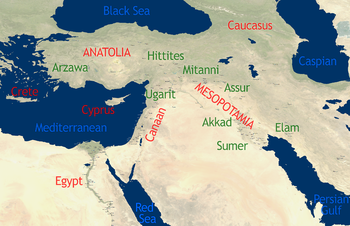35 Ancient Near East: Cradle of Civilization
Defining Civilization
There are many ways to define the word civilization, but all civilizations seem to have some things in common despite the fact that they developed independently in different parts of the world and at different times. Civilizations have complex social orders and high degrees of technological development. Key elements include food production through agriculture (large scale farming and animal husbandry), occupational specialization, writing, and the production and use of bronze. (Adapted from Frank, Patrick, Preble’s Artforms, 10th edition, 2011, Upper Saddle River, NJ)
The Cradle of Civilization
Mesopotamia, the area between the Tigris and Euphrates Rivers (in modern day Iraq), is often referred to as the cradle of civilization because it is the first place where complex urban centers grew. The history of Mesopotamia, however, is inextricably tied to the greater region, which is comprised of the modern nations of Egypt, Iran, Syria, Jordan, Israel, Lebanon, the Gulf states and Turkey. We often refer to this region as the Near or Middle East.
What’s in a Name?
Why is this region named this way? What is it in the middle of or near to? It is the proximity of these countries to the West (to Europe) that led this area to be termed “the near east.” Ancient Near Eastern Art has long been part of the history of Western art, but history didn’t have to be written this way. It is largely because of the West’s interests in the Biblical “Holy Land” that ancient Near Eastern materials have been regarded as part of the Western canon of the history of art.

The Land of the Bible

A Complex History
The history of the Ancient Near East is complex and the names of rulers and locations are often difficult to read, pronounce and spell. Moreover, this is a part of the world which today remains remote from the West culturally while political tensions have impeded mutual understanding. However, once you get a handle on the general geography of the area and its history, the art reveals itself as uniquely beautiful, intimate and fascinating in its complexity.

Geography and the Growth of Cities
Mesopotamia remains a region of stark geographical contrasts: vast deserts rimmed by rugged mountain ranges, punctuated by lush oases. Flowing through this topography are rivers and it was the irrigation systems that drew off the water from these rivers, specifically in southern Mesopotamia, that provided the support for the very early urban centers here.
The region lacks stone (for building) and precious metals and timber. Historically, it has relied on the long-distance trade of its agricultural products to secure these materials. The large-scale irrigation systems and labor required for extensive farming was managed by a centralized authority. The early development of this authority, over large numbers of people in an urban center, is really what distinguishes Mesopotamia and gives it a special position in the history of Western culture. Here, for the first time, thanks to ample food and a strong administrative class, the West develops a very high level of craft specialization and artistic production.
Sumerian Art
The region of southern Mesopotamia is known as Sumer, and it is in Sumer that we find some of the oldest known cities, including Ur and Uruk.
Uruk
Prehistory in this part of the world ends with the city of Uruk, where we find some of the earliest written records. This large city-state (and it environs) was largely dedicated to agriculture and eventually dominated southern Mesopotamia. Uruk perfected Mesopotamian irrigation and administration systems.
An Agricultural Theocracy
Cuneiform tablet still in its clay case: legal case from Niqmepuh, King of Iamhad (Aleppo),
1720 B.C.E., 3.94 x 2″ (British Museum)
Within the city of Uruk, there was a large temple complex dedicated to Innana, the patron goddess of the city. The City-State’s agricultural production would be “given” to her and stored at her temple. Harvested crops would then be processed (grain ground into flour, barley fermented into beer) and given back to the citizens of Uruk in equal share at regular intervals.
The head of the temple administration, the chief priest of Innana, also served as political leader, making Uruk the first known theocracy.
We know many details about this theocratic administration because the Sumerians left numerous documents in cuneiform script.
These tablets made of dried mud and many were sealed in clay envelopes and signed using cylinder seals. A cylinder seals is a small pierced object like a long bead that is carved in reverse (intaglio) with a unique image and sometimes the name of the owner.
The seal was rolled over the soft clay of a tablet and functioned as a signature. The minute images on these seals use a system of symbolic representation that identifies the political status of the owner.

Lapis Lazuli Cylinder Seal with a modern impression,
From Ur, southern Iraq, c. 2600 B.C.E. (British Museum)



